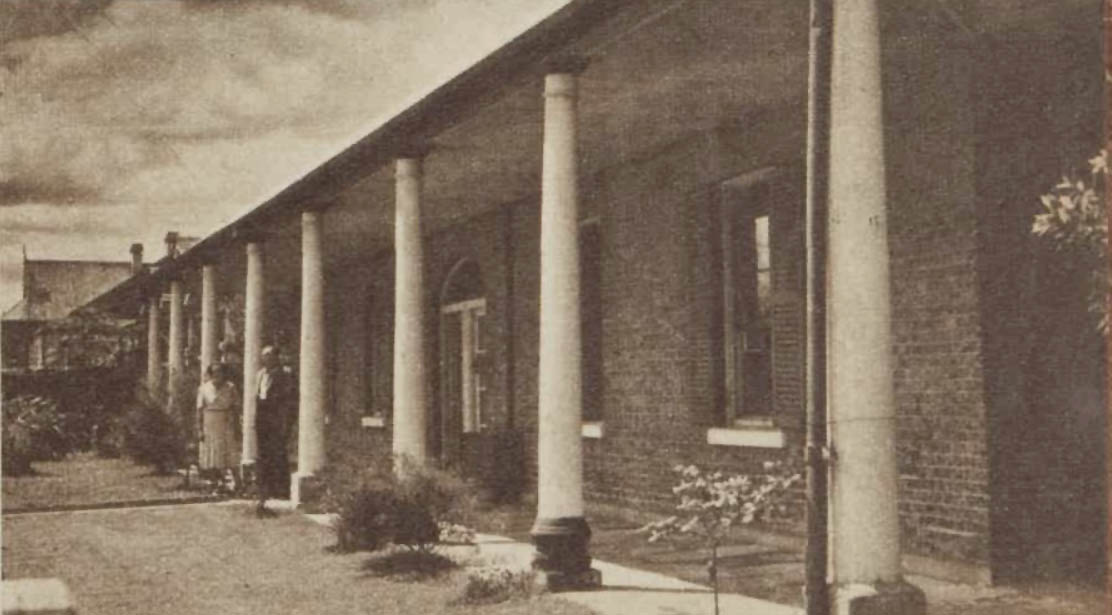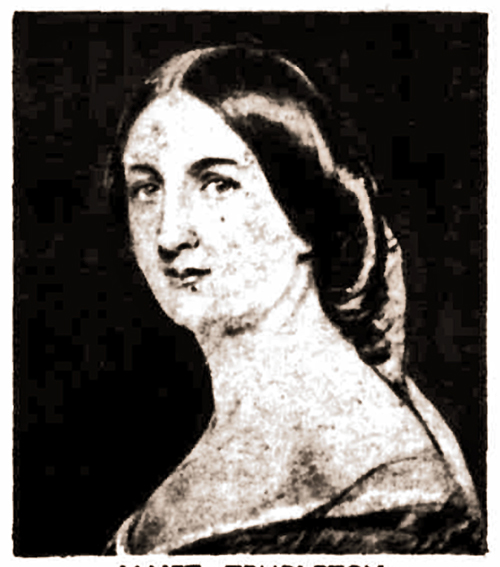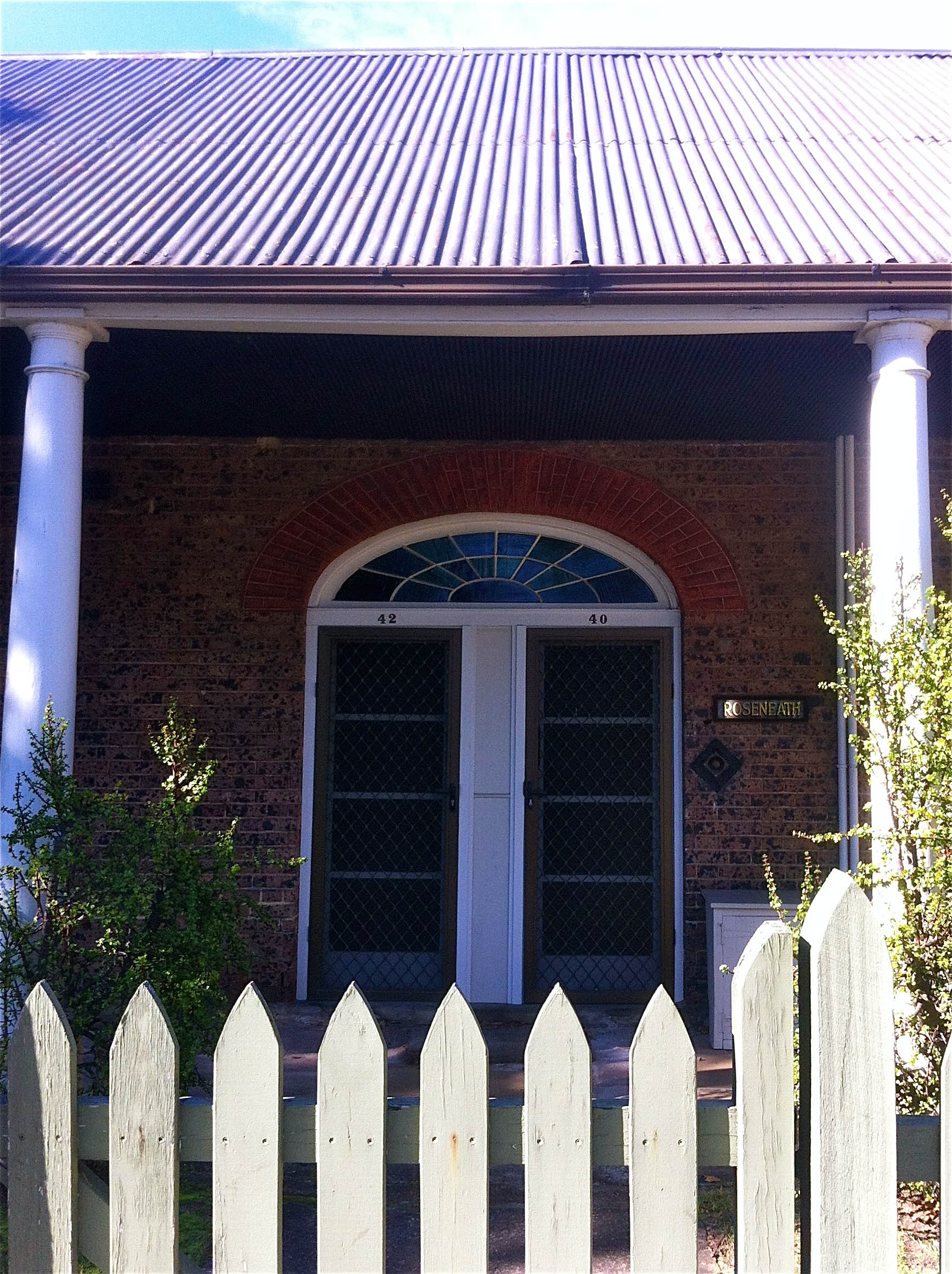The Dictionary of Sydney was archived in 2021.
Roseneath Cottage
Citation
Persistent URL for this entry
To cite this entry in text
To cite this entry in a Wikipedia footnote citation
To cite this entry as a Wikipedia External link
Roseneath Cottage
[media]Roseneath is a privately owned, single-storey sandstock brick cottage of the Colonial Georgian style. State heritage-listed, it was built between 1835 and 1837 to house Janet Templeton – a Scottish widow who became a pioneering pastoralist in Australia – and her children. Primarily a private family residence, the property's abundant features led to its use in the latter half of the nineteenth and early twentieth centuries as a number of small denominational private schools, one of which developed into Tara, a major independent school for girls in Parramatta. The cottage is situated on the corner of O'Connell and Ross streets adjacent to the Ross Street entrance of the Our Lady of Mercy College campus, Parramatta. Today, Roseneath also overlooks the northern section of Parramatta Park (the former Governor's Domain) including the park's Ross Street Gatehouse and the Parramatta Leagues Club. In the early colonial era, though, Roseneath's distinguished residents would have had a noteworthy addition to this outlook as convict iron gangs numbering up to three hundred men passed by their elegant abode on a daily basis. [1]
A pastoral pioneer's home
Roseneath [media]is most associated with Janet Templeton, a pioneer of Australia's wool industry. After the death of her wealthy Glaswegian husband, Andrew Templeton, in 1829, Janet resolved to emigrate with her relatives, the Forlonges, to Van Diemen's Land with a flock of the finest merino sheep from Saxony. Once the sheep had been purchased and driven from Saxony across Germany and Hamburg and finally arrived in England, Janet chartered a brig, the Czar , and set sail from Scotland in August 1830 with her family, servants, shepherds, 63 Saxon merino sheep, six horses, agricultural equipment, and furniture. [2] The Templetons and Forlonges settled in Van Diemen's Land and Kelburn at Goulburn; thus Janet became one of the first women in Australia to breed sheep of the prized Forlonge bloodline and is also credited with introducing them to Victoria.
Janet made her way to Sydney and lived in Concord until around 1835 when she bought land previously granted to Parramatta miller Henry Harvey. [3] Construction of Roseneath Cottage commenced in this period and was completed sometime before 1837, as a newspaper notice indicates one of Janet’s daughters married there that year. [4]
[media]The symmetry that is so characteristic of the Colonial Georgian architectural style is on full display at Roseneath. Central to four evenly spaced twelve-panel windows with shutters is a 3 feet 5 inch (1.04 metre) wide doorway with an elliptical fanlight that serves as the cottage's simple but elegant main entrance. [5] The main façade's most outstanding feature, however, is the sandstone-flagged verandah that wraps around three sides of the house and is held up by turned timber columns. Along with the house itself, the verandah is covered over by a 'flattish shingle roof...in one gradual slope.' [6] [media]By the 1830s when Roseneath was constructed, verandahs like this were just beginning to be seen as a necessary guard against the harsh Australian climate. [7]
The predominant colour of the cottage brickwork has been described as 'mottled fawn and grey.' [8] However, this colouration is subtly offset by the 'soft red rubbing brick lintels' above the door and windows; a feature that in the cottage's original visage was, according to one short-term resident, 'hardly to be distinguished, owing to the beautiful creepers that surround it hanging in thick festoons from column to column of the verandah which makes a delightfully cool walk round three sides.' [9] Indeed, the garden, which contained a sunken well providing accessible water, was by all accounts 'excellent...well stocked with fruit trees' [10] such as oranges, apples, pears, plums, apricots and peaches, nectarines, vines and mulberries [11] as well as 'a variety of beautiful shrubs,' [12] all planted by the unstoppable Janet Templeton. 'Ivy, passion flowers, bignonia, honey-suckle and many others all growing most luxuriantly – while the beds are filled with geraniums and roses...', Emily Darvall gushed in a private letter written during her time there in 1840.
In 1837 the cottage's interior contained a 12 feet (approximately 3.6 metre) wide hall running the full length of the house with 'large dining and drawing rooms,' [13] one main bedroom and two small bedrooms. And though this was a single-storey building, attic space was used for an additional three large bedrooms which were accessed by a steep narrow staircase. [14] A 'detached kitchen, laundry, store, servants' apartments, stable, and coachhouse' [15] were also part of this impressive colonial property.
The acquisition of the Roseneath property was not without its difficulties. Originally the land Roseneath was built on had been part of 105 acres (approximately 42.5 hectares) granted to Governor Bligh. By July 1839 the land allocated to Bligh included Roseneath, numerous other residential properties as well as the Parramatta Female Factory, The King's School, the Roman Catholic chapel and school and the proposed location of Parramatta's much-needed new stone gaol which had already been designed. At this time, however, Bligh's heirs laid claim to the original grant and took legal action to have the current residents, including Janet Templeton, evicted before the case was resolved in 1841 in favour of those who were residing there. [16] Nevertheless, the family's pastoral interests in Port Phillip and Goulburn meant that Janet did not reside at Roseneath for long anyway. [17] We know that in 1840 she briefly leased the house to Major Edward Darvall and his family who brought with them 'a black Portuguese cook who spoke little English and a "lazy wild Irish girl" as housemaid,' [18] but Janet did not officially leave Roseneath until 1842. By August 1844 Roseneath was occupied by Mrs Colonel Anderson and the property was advertised 'to be let or sold' in the Sydney Morning Herald. [19]
School days
For the remainder of the nineteenth century, Roseneath was regularly listed as being available as a rental property, attracting Reverend James Carter, who briefly resided there with his family, as well as a number of lessees who viewed its numerous commodious rooms as the ideal setting for their private schools.
These private schools included Mr Baly’s Boarding Establishment for Young Gentlemen, (August 1854 – June 1855); a 'first-class boarding school for young ladies,’ initially run by Mrs Mary W M'Ghie (January–December 1862) then Mrs and Miss Farmer (December 1862–July 1864); and St Ronan's, a 'High Class Day and Boarding School for Girls,' (October 1887–1889).
It is believed that sixteen-year-old Miss Mary Elizabeth (Joan) Waugh, who was educated locally at Miss Bell's Perth House School, began her teaching career in earnest at Roseneath, as it is likely she was the young accomplished governess referred to in a St Ronan's advertisement in March 1888. Waugh would go on to conduct morning classes for St Ronan's young ladies almost a decade later at the school's George Street location before eventually moving her classes in 1912 to her family home, 'Tara,' also in George Street. Thus, Roseneath was very much the bud from which Tara Anglican School for Girls bloomed.
After Mrs Mills and Miss Waugh appropriated the space for their classrooms, it seems Roseneath ceased to be used as anything other than what Janet Templeton originally intended it to be – a charming, private family residence.
References
Adams, Nancy. Saxon Sheep: A Novel Based on the Activities of the Templeton and Forlonge Families in the Early Days of Australian Settlement. Melbourne: Cheshire, 1961.
Hubbard, Bronwyn. Tara: A Telling of the Tapestry. Parramatta: Tara Anglican School for Girls, 1997.
Kass, Terry, Carol Liston and John McClymont, John. Parramatta: A Past Revealed. Parramatta: Parramatta City Council, 1996.
Leary, Frank and Judith Frank. Colonial Heritage: Historic Buildings of New South Wales. Sydney, London: Angus and Robertson, 1972.
Lewis, Miles. Australian Building: A Cultural Investigation. http://www.mileslewis.net/australian-building/pdf/10-climatic-design/10.02-verandah-australia.pdf. Viewed 25 June 2014.
Long, Jeremy, ed. Strugglers and Settlers. Darvall Family Letters 1839–49. Springwood: Butterfly Books, 1994.
'Roseneath Cottage, 40–42 O'Connell St, Parramatta, NSW, Australia.' Australian Heritage Database, Australian Government Department of the Office of Environment. http://www.environment.gov.au/cgi-bin/ahdb/search.pl?mode=place_detail;place_id=3038. Viewed 22 June 2014.
'Roseneath Cottage.' State Heritage Register, Heritage Council of NSW supported by the Heritage Division of the Office of Environment and Heritage. http://www.environment.nsw.gov.au/heritageapp/ViewHeritageItemDetails.aspx?ID=5045134. Viewed 25 June 2014.
Roxburgh, Rachel. Early Colonial Houses of New South Wales. Sydney: Ure Smith, 1974.
Notes
[1] Terry Kass, Carol Liston, and John McClymont, Parramatta: A Past Revealed (Parramatta: Parramatta City Council, 1996), 160. Thanks to Diana Tilley-Winyard, archivist at Tara Anglican School for Girls, and Anne Tsang at the Parramatta Heritage Centre for their assistance with the research for this entry regarding the private schools of Roseneath.
[2] RVB and AS Kenyon, 'Romance of the Forlonge Merinoes,' The Argus, 23 August 1934, 5
[3] 'Roseneath Cottage, 40–42 O'Connell St, Parramatta, NSW, Australia,' Australian Heritage Database, Australian Government Department of the Office of Environment, http://www.environment.gov.au/cgi-bin/ahdb/search.pl?mode=place_detail;place_id=3038, viewed 22 June 2014; 'Roseneath Cottage,' State Heritage Register, Heritage Council of NSW supported by the Heritage Division of the Office of Environment and Heritage, http://www.environment.nsw.gov.au/heritageapp/ViewHeritageItemDetails.aspx?ID=5045134, viewed 25 June 2014
[4] 'Family Notices,' Sydney Gazette and New South Wales Advertiser, Thursday 15 June 1837, 3; 'Family Notices,' The Sydney Herald, Thursday 15 June 1837, 3.
[5] 'Roseneath Cottage,' State Heritage Register, Heritage Council of NSW supported by the Heritage Division of the Office of Environment and Heritage, http://www.environment.nsw.gov.au/heritageapp/ViewHeritageItemDetails.aspx?ID=5045134, viewed 25 June 2014
[6] Rachel Roxburgh, Early Colonial Houses of New South Wales, (Sydney: Ure Smith, 1974), 200, quoted in Jeremy Long, ed, Strugglers and Settlers, Darvall Family Letters 1839–1849 (Springwood: Butterfly Books, 1994), 123, 125, 165; Terry Kass, Carol Liston, and John McClymont, Parramatta: A Past Revealed (Parramatta: Parramatta City Council, 1996), 160
[7] Miles Lewis, Australian Building: A Cultural Investigation, http://www.mileslewis.net/australian-building/pdf/10-climatic-design/10.02-verandah-australia.pdf, viewed 25 June 2014
[8] Leary, Frank and Judith Leary, Colonial Heritage: Historic Buildings of New South Wales (Sydney; London: Angus and Robertson, 1972), 139
[9] Rachel Roxburgh, Early Colonial Houses of New South Wales (Sydney: Ure Smith, 1974), 200, quoted in Jeremy Long, ed, Strugglers and Settlers, Darvall Family Letters 1839–1849 (Springwood: Butterfly Books, 1994), 123, 125, 165; Terry Kass, Carol Liston, and John McClymont, Parramatta: A Past Revealed (Parramatta: Parramatta City Council, 1996), 160
[10] 'Advertising,' Sydney Morning Herald, Monday 13 February 1843, 4
[11] Nancy Adams, Saxon Sheep: A Novel Based on the Activities of the Templeton and Forlong Families in the Early Days of Australian Settlement (Melbourne: Cheshire, 1961), 119–120, cited in 'Roseneath Cottage,' State Heritage Register, Heritage Council of NSW supported by the Heritage Division of the Office of Environment and Heritage, http://www.environment.nsw.gov.au/heritageapp/ViewHeritageItemDetails.aspx?ID=5045134, viewed 25 June 2014
[12] 'Advertising,' Sydney Morning Herald, Monday 13 February 1843, 4
[13] 'Advertising,' Sydney Morning Herald, Monday 13 February 1843, 4; 'Advertising,' Sydney Morning Herald, Thursday 22 August 1844 4
[14] Nancy Adams, Saxon Sheep: A Novel Based on the Activities of the Templeton and Forlong Families in the Early Days of Australian Settlement (Melbourne: Cheshire, 1961), 119–120, cited in 'Roseneath Cottage,' State Heritage Register, Heritage Council of NSW supported by the Heritage Division of the Office of Environment and Heritage, http://www.environment.nsw.gov.au/heritageapp/ViewHeritageItemDetails.aspx?ID=5045134, viewed 25 June 2014
[15] 'Advertising,' Sydney Morning Herald, Monday 13 February 1843, 4
[16] Terry Kass, Carol Liston, and John McClymont, Parramatta: A Past Revealed (Parramatta: Parramatta City Council, 1996), 139–40
[17] Terry Kass, Carol Liston, and John McClymont, Parramatta: A Past Revealed (Parramatta: Parramatta City Council, 1996), 160
[18] Terry Kass, Carol Liston, and John McClymont, Parramatta: A Past Revealed (Parramatta: Parramatta City Council, 1996), 160
[19] 'Advertising,' Sydney Morning Herald, Thursday 22 August 1844, 4






